Nd:YAG Laser Line Mirrors

- Mirrors for Nd:YAG Wavelengths from Fundamental to 4th Harmonic
- High Damage Thresholds (See Values Below)
- Each Coating Effective from 0º to 45º AOI
NB1-K08
Ø1", 3rd Harmonic
NB05-K12
Ø1/2", 2nd Harmonic
NB1-K04
Ø1", 4th Harmonic
NB2-K13
Ø2", Fundamental & 2nd Harmonic
NB07-K14
Ø19 mm, Fundamental

Please Wait
| Mirror Specifications | ||
|---|---|---|
| Front Surface Flatness | λ/10 at 633 nm | |
| Surface Quality | 10-5 Scratch-Dig | |
| Back Surface | Fine Grounda | |
| Parallelism | ≤3 arcmin | |
| Diameter Tolerance | +0.0 mm/-0.1 mm | |
| Clear Aperture | >80% of Diameter | |
| Thickness | Ø1/2", Ø19 mm, Ø1" Optics | 6 mm ± 0.2 mm |
| Ø2" Optics | 12 mm ± 0.2 mm | |
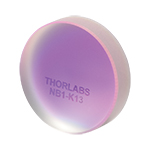
Click to Enlarge
Mirrors are engraved on the back side for easy identification.
Features
- Five Dielectric Nd:YAG Coatings Available
- Fundamental: 1047 - 1064 nm
- Fundamental & 2nd Harmonic (Dual Order): 532 nm & 1064 nm
- 2nd Harmonic: 524 - 532 nm
- 3rd Harmonic: 349 - 355 nm
- 4th Harmonic: 262 - 266 nm
- Designed for Incident Angles in 0° to 45° Range
- High Reflectance for Both S- and P-Polarized Light
- Available in Ø1/2", Ø19 mm, Ø1", and Ø2" Sizes
The laser line mirrors on this webpage are designed for the fundamental, 2nd harmonic, 3rd harmonic, and 4th harmonic of Nd:YAG lasers. Their dielectric coatings offer high reflectance for s- and p-polarized light, as shown in the table below, and also provide high damage thresholds. Each coating operates over angles of incidence (AOI) from 0° to 45°, allowing the same mirrors to be used in a variety of optical setup layouts.
These mirrors are offered on Ø1/2", Ø19 mm, Ø1", and Ø2" substrates. Ø19 mm mirrors are specifically designed to fit our Polaris Fixed Optic Mounts for laser system design and other OEM applications. This diameter provides a larger clear aperture than Ø1/2" optics while allowing the mounts to maintain a Ø1" footprint.
| Nd:YAG Laser Line Mirrors | |||||
|---|---|---|---|---|---|
| Coating Designation (Quick Links) |
Wavelength | Reflectance Data and Graphs |
Reflectance | Damage Threshold | |
| K14 | 1047 - 1064 nm Fundamental |
Ravg > 99.5% (S- and P-Pol.) | Pulse: 25 J/cm2 (1064 nm, Ø0.552 mm, 10 ns, 10 Hz) CWa,b: 20 kW/cm (1070 nm, Ø0.974 mm) |
||
| K13 | 532 nm & 1064 nm Fundamental & 2nd Harmonic |
532 nm: R > 98.0% (S- and P-Pol.) 1064 nm: R > 99.0% (S- and P-Pol.) |
8 J/cm2 (532 nm, Ø0.491 mm, 10 ns, 10 Hz) 5 J/cm2 (1064 nm, Ø1.010 mm, 10 ns, 10 Hz) |
||
| K12 | 524 - 532 nm 2nd Harmonic |
Ravg > 99.5% (S-Pol.) Ravg > 99.0% (P-Pol.) |
Pulse: 8 J/cm2 (532 nm, Ø0.491 mm, 10 ns, 10 Hz) CWa,b: 550 W/cm (532 nm, Ø1.000 mm) |
||
| K08 | 349 - 355 nm 3rd Harmonic |
Ravg > 99.5% (S- and P-Pol.) | 3.5 J/cm2 (355 nm, Ø0.350 mm, 10 ns, 10 Hz) | ||
| K04 | 262 - 266 nm 4th Harmonic |
Ravg > 99.0% (S- and P-Pol.) | 2 J/cm2 (266 nm, Ø0.416 mm, 10 ns, 10 Hz) | ||
| Damage Threshold Specifications | ||
|---|---|---|
| Coating Designation (Item # Suffix) |
Damage Threshold | |
| -K14 | Pulse | 25 J/cm2 (1064 nm, 10 ns, 10 Hz, Ø0.552 mm) |
| CWa,b | 20 kW/cm (1070 nm, Ø0.974 mm) | |
| -K13 | Pulse | 8 J/cm2 (532 nm, 10 ns, 10 Hz, Ø0.491 mm) 5 J/cm2 (1064 nm, 10 ns, 10 Hz, Ø1.010 mm) |
| -K12 | Pulse | 8 J/cm2 (532 nm, 10 ns, 10 Hz, Ø0.491 mm) |
| CWa,b | 550 W/cm (532 nm, Ø1.000 mm) | |
| -K08 | Pulse | 3.5 J/cm2 (355 nm, 10 ns, 10 Hz, Ø0.350 mm) |
| -K04 | Pulse | 2 J/cm2 (266 nm, 10 ns, 10 Hz, Ø0.416 mm) |
Damage Threshold Data for Thorlabs' Nd:YAG Laser Line Mirrors
The specifications to the right are measured data for Thorlabs' Nd:YAG laser line mirrors.
Laser Induced Damage Threshold Tutorial
The following is a general overview of how laser induced damage thresholds are measured and how the values may be utilized in determining the appropriateness of an optic for a given application. When choosing optics, it is important to understand the Laser Induced Damage Threshold (LIDT) of the optics being used. The LIDT for an optic greatly depends on the type of laser you are using. Continuous wave (CW) lasers typically cause damage from thermal effects (absorption either in the coating or in the substrate). Pulsed lasers, on the other hand, often strip electrons from the lattice structure of an optic before causing thermal damage. Note that the guideline presented here assumes room temperature operation and optics in new condition (i.e., within scratch-dig spec, surface free of contamination, etc.). Because dust or other particles on the surface of an optic can cause damage at lower thresholds, we recommend keeping surfaces clean and free of debris. For more information on cleaning optics, please see our Optics Cleaning tutorial.
Testing Method
Thorlabs' LIDT testing is done in compliance with ISO/DIS 11254 and ISO 21254 specifications.
First, a low-power/energy beam is directed to the optic under test. The optic is exposed in 10 locations to this laser beam for 30 seconds (CW) or for a number of pulses (pulse repetition frequency specified). After exposure, the optic is examined by a microscope (~100X magnification) for any visible damage. The number of locations that are damaged at a particular power/energy level is recorded. Next, the power/energy is either increased or decreased and the optic is exposed at 10 new locations. This process is repeated until damage is observed. The damage threshold is then assigned to be the highest power/energy that the optic can withstand without causing damage. A histogram such as that below represents the testing of one BB1-E02 mirror.

The photograph above is a protected aluminum-coated mirror after LIDT testing. In this particular test, it handled 0.43 J/cm2 (1064 nm, 10 ns pulse, 10 Hz, Ø1.000 mm) before damage.

| Example Test Data | |||
|---|---|---|---|
| Fluence | # of Tested Locations | Locations with Damage | Locations Without Damage |
| 1.50 J/cm2 | 10 | 0 | 10 |
| 1.75 J/cm2 | 10 | 0 | 10 |
| 2.00 J/cm2 | 10 | 0 | 10 |
| 2.25 J/cm2 | 10 | 1 | 9 |
| 3.00 J/cm2 | 10 | 1 | 9 |
| 5.00 J/cm2 | 10 | 9 | 1 |
According to the test, the damage threshold of the mirror was 2.00 J/cm2 (532 nm, 10 ns pulse, 10 Hz, Ø0.803 mm). Please keep in mind that these tests are performed on clean optics, as dirt and contamination can significantly lower the damage threshold of a component. While the test results are only representative of one coating run, Thorlabs specifies damage threshold values that account for coating variances.
Continuous Wave and Long-Pulse Lasers
When an optic is damaged by a continuous wave (CW) laser, it is usually due to the melting of the surface as a result of absorbing the laser's energy or damage to the optical coating (antireflection) [1]. Pulsed lasers with pulse lengths longer than 1 µs can be treated as CW lasers for LIDT discussions.
When pulse lengths are between 1 ns and 1 µs, laser-induced damage can occur either because of absorption or a dielectric breakdown (therefore, a user must check both CW and pulsed LIDT). Absorption is either due to an intrinsic property of the optic or due to surface irregularities; thus LIDT values are only valid for optics meeting or exceeding the surface quality specifications given by a manufacturer. While many optics can handle high power CW lasers, cemented (e.g., achromatic doublets) or highly absorptive (e.g., ND filters) optics tend to have lower CW damage thresholds. These lower thresholds are due to absorption or scattering in the cement or metal coating.

LIDT in linear power density vs. pulse length and spot size. For long pulses to CW, linear power density becomes a constant with spot size. This graph was obtained from [1].

Pulsed lasers with high pulse repetition frequencies (PRF) may behave similarly to CW beams. Unfortunately, this is highly dependent on factors such as absorption and thermal diffusivity, so there is no reliable method for determining when a high PRF laser will damage an optic due to thermal effects. For beams with a high PRF both the average and peak powers must be compared to the equivalent CW power. Additionally, for highly transparent materials, there is little to no drop in the LIDT with increasing PRF.
In order to use the specified CW damage threshold of an optic, it is necessary to know the following:
- Wavelength of your laser
- Beam diameter of your beam (1/e2)
- Approximate intensity profile of your beam (e.g., Gaussian)
- Linear power density of your beam (total power divided by 1/e2 beam diameter)
Thorlabs expresses LIDT for CW lasers as a linear power density measured in W/cm. In this regime, the LIDT given as a linear power density can be applied to any beam diameter; one does not need to compute an adjusted LIDT to adjust for changes in spot size, as demonstrated by the graph to the right. Average linear power density can be calculated using the equation below.

The calculation above assumes a uniform beam intensity profile. You must now consider hotspots in the beam or other non-uniform intensity profiles and roughly calculate a maximum power density. For reference, a Gaussian beam typically has a maximum power density that is twice that of the uniform beam (see lower right).
Now compare the maximum power density to that which is specified as the LIDT for the optic. If the optic was tested at a wavelength other than your operating wavelength, the damage threshold must be scaled appropriately. A good rule of thumb is that the damage threshold has a linear relationship with wavelength such that as you move to shorter wavelengths, the damage threshold decreases (i.e., a LIDT of 10 W/cm at 1310 nm scales to 5 W/cm at 655 nm):

While this rule of thumb provides a general trend, it is not a quantitative analysis of LIDT vs wavelength. In CW applications, for instance, damage scales more strongly with absorption in the coating and substrate, which does not necessarily scale well with wavelength. While the above procedure provides a good rule of thumb for LIDT values, please contact Tech Support if your wavelength is different from the specified LIDT wavelength. If your power density is less than the adjusted LIDT of the optic, then the optic should work for your application.
Please note that we have a buffer built in between the specified damage thresholds online and the tests which we have done, which accommodates variation between batches. Upon request, we can provide individual test information and a testing certificate. The damage analysis will be carried out on a similar optic (customer's optic will not be damaged). Testing may result in additional costs or lead times. Contact Tech Support for more information.
Pulsed Lasers
As previously stated, pulsed lasers typically induce a different type of damage to the optic than CW lasers. Pulsed lasers often do not heat the optic enough to damage it; instead, pulsed lasers produce strong electric fields capable of inducing dielectric breakdown in the material. Unfortunately, it can be very difficult to compare the LIDT specification of an optic to your laser. There are multiple regimes in which a pulsed laser can damage an optic and this is based on the laser's pulse length. The highlighted columns in the table below outline the relevant pulse lengths for our specified LIDT values.
Pulses shorter than 10-9 s cannot be compared to our specified LIDT values with much reliability. In this ultra-short-pulse regime various mechanics, such as multiphoton-avalanche ionization, take over as the predominate damage mechanism [2]. In contrast, pulses between 10-7 s and 10-4 s may cause damage to an optic either because of dielectric breakdown or thermal effects. This means that both CW and pulsed damage thresholds must be compared to the laser beam to determine whether the optic is suitable for your application.
| Pulse Duration | t < 10-9 s | 10-9 < t < 10-7 s | 10-7 < t < 10-4 s | t > 10-4 s |
|---|---|---|---|---|
| Damage Mechanism | Avalanche Ionization | Dielectric Breakdown | Dielectric Breakdown or Thermal | Thermal |
| Relevant Damage Specification | No Comparison (See Above) | Pulsed | Pulsed and CW | CW |
When comparing an LIDT specified for a pulsed laser to your laser, it is essential to know the following:

LIDT in energy density vs. pulse length and spot size. For short pulses, energy density becomes a constant with spot size. This graph was obtained from [1].
- Wavelength of your laser
- Energy density of your beam (total energy divided by 1/e2 area)
- Pulse length of your laser
- Pulse repetition frequency (prf) of your laser
- Beam diameter of your laser (1/e2 )
- Approximate intensity profile of your beam (e.g., Gaussian)
The energy density of your beam should be calculated in terms of J/cm2. The graph to the right shows why expressing the LIDT as an energy density provides the best metric for short pulse sources. In this regime, the LIDT given as an energy density can be applied to any beam diameter; one does not need to compute an adjusted LIDT to adjust for changes in spot size. This calculation assumes a uniform beam intensity profile. You must now adjust this energy density to account for hotspots or other nonuniform intensity profiles and roughly calculate a maximum energy density. For reference a Gaussian beam typically has a maximum energy density that is twice that of the 1/e2 beam.
Now compare the maximum energy density to that which is specified as the LIDT for the optic. If the optic was tested at a wavelength other than your operating wavelength, the damage threshold must be scaled appropriately [3]. A good rule of thumb is that the damage threshold has an inverse square root relationship with wavelength such that as you move to shorter wavelengths, the damage threshold decreases (i.e., a LIDT of 1 J/cm2 at 1064 nm scales to 0.7 J/cm2 at 532 nm):

You now have a wavelength-adjusted energy density, which you will use in the following step.
Beam diameter is also important to know when comparing damage thresholds. While the LIDT, when expressed in units of J/cm², scales independently of spot size; large beam sizes are more likely to illuminate a larger number of defects which can lead to greater variances in the LIDT [4]. For data presented here, a <1 mm beam size was used to measure the LIDT. For beams sizes greater than 5 mm, the LIDT (J/cm2) will not scale independently of beam diameter due to the larger size beam exposing more defects.
The pulse length must now be compensated for. The longer the pulse duration, the more energy the optic can handle. For pulse widths between 1 - 100 ns, an approximation is as follows:

Use this formula to calculate the Adjusted LIDT for an optic based on your pulse length. If your maximum energy density is less than this adjusted LIDT maximum energy density, then the optic should be suitable for your application. Keep in mind that this calculation is only used for pulses between 10-9 s and 10-7 s. For pulses between 10-7 s and 10-4 s, the CW LIDT must also be checked before deeming the optic appropriate for your application.
Please note that we have a buffer built in between the specified damage thresholds online and the tests which we have done, which accommodates variation between batches. Upon request, we can provide individual test information and a testing certificate. Contact Tech Support for more information.
[1] R. M. Wood, Optics and Laser Tech. 29, 517 (1998).
[2] Roger M. Wood, Laser-Induced Damage of Optical Materials (Institute of Physics Publishing, Philadelphia, PA, 2003).
[3] C. W. Carr et al., Phys. Rev. Lett. 91, 127402 (2003).
[4] N. Bloembergen, Appl. Opt. 12, 661 (1973).
In order to illustrate the process of determining whether a given laser system will damage an optic, a number of example calculations of laser induced damage threshold are given below. For assistance with performing similar calculations, we provide a spreadsheet calculator that can be downloaded by clicking the button to the right. To use the calculator, enter the specified LIDT value of the optic under consideration and the relevant parameters of your laser system in the green boxes. The spreadsheet will then calculate a linear power density for CW and pulsed systems, as well as an energy density value for pulsed systems. These values are used to calculate adjusted, scaled LIDT values for the optics based on accepted scaling laws. This calculator assumes a Gaussian beam profile, so a correction factor must be introduced for other beam shapes (uniform, etc.). The LIDT scaling laws are determined from empirical relationships; their accuracy is not guaranteed. Remember that absorption by optics or coatings can significantly reduce LIDT in some spectral regions. These LIDT values are not valid for ultrashort pulses less than one nanosecond in duration.

A Gaussian beam profile has about twice the maximum intensity of a uniform beam profile.
CW Laser Example
Suppose that a CW laser system at 1319 nm produces a 0.5 W Gaussian beam that has a 1/e2 diameter of 10 mm. A naive calculation of the average linear power density of this beam would yield a value of 0.5 W/cm, given by the total power divided by the beam diameter:

However, the maximum power density of a Gaussian beam is about twice the maximum power density of a uniform beam, as shown in the graph to the right. Therefore, a more accurate determination of the maximum linear power density of the system is 1 W/cm.
An AC127-030-C achromatic doublet lens has a specified CW LIDT of 350 W/cm, as tested at 1550 nm. CW damage threshold values typically scale directly with the wavelength of the laser source, so this yields an adjusted LIDT value:

The adjusted LIDT value of 350 W/cm x (1319 nm / 1550 nm) = 298 W/cm is significantly higher than the calculated maximum linear power density of the laser system, so it would be safe to use this doublet lens for this application.
Pulsed Nanosecond Laser Example: Scaling for Different Pulse Durations
Suppose that a pulsed Nd:YAG laser system is frequency tripled to produce a 10 Hz output, consisting of 2 ns output pulses at 355 nm, each with 1 J of energy, in a Gaussian beam with a 1.9 cm beam diameter (1/e2). The average energy density of each pulse is found by dividing the pulse energy by the beam area:

As described above, the maximum energy density of a Gaussian beam is about twice the average energy density. So, the maximum energy density of this beam is ~0.7 J/cm2.
The energy density of the beam can be compared to the LIDT values of 1 J/cm2 and 3.5 J/cm2 for a BB1-E01 broadband dielectric mirror and an NB1-K08 Nd:YAG laser line mirror, respectively. Both of these LIDT values, while measured at 355 nm, were determined with a 10 ns pulsed laser at 10 Hz. Therefore, an adjustment must be applied for the shorter pulse duration of the system under consideration. As described on the previous tab, LIDT values in the nanosecond pulse regime scale with the square root of the laser pulse duration:

This adjustment factor results in LIDT values of 0.45 J/cm2 for the BB1-E01 broadband mirror and 1.6 J/cm2 for the Nd:YAG laser line mirror, which are to be compared with the 0.7 J/cm2 maximum energy density of the beam. While the broadband mirror would likely be damaged by the laser, the more specialized laser line mirror is appropriate for use with this system.
Pulsed Nanosecond Laser Example: Scaling for Different Wavelengths
Suppose that a pulsed laser system emits 10 ns pulses at 2.5 Hz, each with 100 mJ of energy at 1064 nm in a 16 mm diameter beam (1/e2) that must be attenuated with a neutral density filter. For a Gaussian output, these specifications result in a maximum energy density of 0.1 J/cm2. The damage threshold of an NDUV10A Ø25 mm, OD 1.0, reflective neutral density filter is 0.05 J/cm2 for 10 ns pulses at 355 nm, while the damage threshold of the similar NE10A absorptive filter is 10 J/cm2 for 10 ns pulses at 532 nm. As described on the previous tab, the LIDT value of an optic scales with the square root of the wavelength in the nanosecond pulse regime:

This scaling gives adjusted LIDT values of 0.08 J/cm2 for the reflective filter and 14 J/cm2 for the absorptive filter. In this case, the absorptive filter is the best choice in order to avoid optical damage.
Pulsed Microsecond Laser Example
Consider a laser system that produces 1 µs pulses, each containing 150 µJ of energy at a repetition rate of 50 kHz, resulting in a relatively high duty cycle of 5%. This system falls somewhere between the regimes of CW and pulsed laser induced damage, and could potentially damage an optic by mechanisms associated with either regime. As a result, both CW and pulsed LIDT values must be compared to the properties of the laser system to ensure safe operation.
If this relatively long-pulse laser emits a Gaussian 12.7 mm diameter beam (1/e2) at 980 nm, then the resulting output has a linear power density of 5.9 W/cm and an energy density of 1.2 x 10-4 J/cm2 per pulse. This can be compared to the LIDT values for a WPQ10E-980 polymer zero-order quarter-wave plate, which are 5 W/cm for CW radiation at 810 nm and 5 J/cm2 for a 10 ns pulse at 810 nm. As before, the CW LIDT of the optic scales linearly with the laser wavelength, resulting in an adjusted CW value of 6 W/cm at 980 nm. On the other hand, the pulsed LIDT scales with the square root of the laser wavelength and the square root of the pulse duration, resulting in an adjusted value of 55 J/cm2 for a 1 µs pulse at 980 nm. The pulsed LIDT of the optic is significantly greater than the energy density of the laser pulse, so individual pulses will not damage the wave plate. However, the large average linear power density of the laser system may cause thermal damage to the optic, much like a high-power CW beam.
| Posted Comments: | |
Hyungyu Yu
(posted 2024-10-15 14:14:22.377) Could you provide me transmittance and reflectance data of NB1-K04 w.r.t all wavelength available? Craig Cahillane
(posted 2024-05-31 18:50:39.493) Am I understanding correctly the Linear Laser Induced Damage Threshold of 20 kW/cm for the NB1-K14? I am thinking about using this mirror for steering a 70 W 1064 nm Gaussian beam. To be safe and avoid damaging the mirrors, I am wondering what the minimum beam radius should be.
For this linear power density 20 kW/cm, I am calculating radius w = P / LIDT = 35 um. This seems pretty awesome (and much better than other competitors LIDT of around 3 kW/cm^2) if true.
Craig cdolbashian
(posted 2024-06-18 01:17:50.0) Thank you for reaching out to us with this inquiry. The way you have approached this is the typical way to approach this type of calculation. To be on the safe side, you should also include a factor of 2 in the power of your beam to compensate for the localized intensity of a typical gaussian profile near the middle of the beam. Regarding competitors, take note that the quoted damage threshold given by them is in Intensity, while ours in linear density. I have contacted you to discuss this further! MiSeong Kim
(posted 2024-03-25 14:31:41.057) Regarding LIDT, Linear Power Density is difficult to compare to my conditions.
The Linear Power Density of this product is 0.55kW/cm, what is it in kW/cm2? cdolbashian
(posted 2024-03-29 02:41:52.0) Thank you for reaching out to us with this inquiry. I have contacted you directly to share how to convert linear density(W/cm) to power density(W/cm^2). user
(posted 2023-07-31 16:33:51.057) I'm using multiple NB1-K13 products but I cannot find reflectance and transmittance data over broad wavelength from your website. Can you let me know the reflectance and transmittance data of NB1-K13 w.r.t. all of wavelength available? (especially from 300 nm to 900 nm) Thanks in advance. cdolbashian
(posted 2023-08-04 11:17:39.0) Thank you for reaching out to us. While this -K13 coating can be used outside of the specified range, the performance from lot-to-lot will vary. Even though this is the case, I have emailed you with some test data for the range in which you inquired. Hyungyu Yu
(posted 2023-04-04 17:05:01.247) Can you provide reflectance at 266nm? The provided reflectance data is only for near second harmonic wavelength. Thank you in advance! cdolbashian
(posted 2023-04-13 10:46:32.0) Thank you for reaching out to us with this inquiry! We indeed can provide this information. I have reached out to you directly with the requested data. Robert Bernier
(posted 2022-03-10 15:25:30.587) I need to know the LIDT for a CW laser at 1070 nm. The LIDT has been given only for pulsed lasers. cdolbashian
(posted 2022-03-25 12:05:05.0) Thank you for reaching out to us Robert. Unfortunately, we do not have test data for this component for a CW beam. I have reached out to you directly to discuss a bit more about your laser, your application, and the feasibility of using this mirror. user
(posted 2022-03-09 18:03:18.057) Could you provide me the reflectivity data of the mirror NB1-K08 (and NB1-J08 if possible) @ 532 nm? We have a faint green light and we are happy if we can eliminate the green light using these mirrors. jdelia
(posted 2022-03-10 03:18:34.0) Thank you for contacting Thorlabs. I have reached out to you directly to send you the extended reflectance data for our NB1-K08 mirror. We unfortunately do not have any additional data on the obsolete NB1-J08. Yaqing Zhang
(posted 2021-03-18 16:44:24.627) Hi, could you please provide me with the raw data or graph of this mirror's transmission in the white light range (400-700 nm)? I am expecting this mirror has a high reflectance (>95%) for both 515 nm and 1030 nm wavelength, and has a high transmission (>80%) for white light (for example, 400-490 nm and 550 nm -700 nm), is this true? Thank you very much! asundararaj
(posted 2021-03-22 08:35:39.0) Thank you for contacting Thorlabs. I have reached out to you with extended data that we have on the reflectivity of the -K13 coated mirrors in the visible range. CHEN LEE
(posted 2020-09-22 04:36:49.797) We want to separate wavelength from 1064nm、532nm、355nm. So If I use NB1-K08, How many is reflection of 1064nm and 532nm ? And If I use NB1-K12, How many is reflection of 1064nm and 355nm ? YLohia
(posted 2020-09-23 04:04:03.0) Thank you for contacting Thorlabs. I have reached out to you with extended range reflectivity data for these mirrors. Please also note that we offer Nd:YAG Harmonic Beamsplitters here: https://www.thorlabs.com/newgrouppage9.cfm?objectgroup_id=7035 Anderson Hung
(posted 2020-03-25 16:40:21.697) Dear Sir/Madam:
I would like to know the substrate material of this product.
Thank you very much! YLohia
(posted 2020-03-25 10:59:44.0) Hello, thank you for contacting Thorlabs. The substrate of NB07-K12 is made of Fused Silica. Pawel Czuma
(posted 2020-02-22 04:38:19.493) Dear Sir/Madam
Could I use NB1-K04 beam with following laser beam parameters: Gaussian, 3mm diameter, 40uJ, 257nm, 150fs pulse duration, 50kHz repetition rate?
Best Regards,
Pawel Czuma llamb
(posted 2020-02-25 02:45:34.0) Hello Pawel, thank you for contacting Thorlabs. Unfortunately we do not have damage threshold test data for fs pulses, particularly at your fairly high rep rate. I have reached out to you directly to discuss your application further. M. S. Mohamed
(posted 2019-11-27 14:30:00.98) Can you please provide me with the raw data or graph for the reflectance of the NB1-K04 mirror in the wavelength range of 200-500 nm?
Thanks. llamb
(posted 2019-12-02 11:02:02.0) Thank you for contacting Thorlabs. We will reach out to you directly with this reflectance data. Rafael Barros
(posted 2019-09-02 20:29:03.823) Hello, could you please provide the plot of reflectance vs AOI for the NB1-K13 mirror? I read in the comments that performance at oblique incidence may vary between coating runs, but a sample graph or spreadsheet would be sufficient to have an idea. The AOI necessary for my experiment is of 70º. Thank you in advance! YLohia
(posted 2019-09-04 03:32:50.0) Hello, thank you for contacting Thorlabs. I have reached out to you directly with this data. f.huber
(posted 2019-02-06 15:48:00.64) We have a NdYAG Laser 1064nm with a Pilotlaser of wavelength (630 - 670). Is it possible to use the K13 Mirror (532 nm & 1064 nm Fundamental & 2nd Harmonic) in order to see the Pilotlaser? Is a graph in the wavelength range of the Pilotlaser available?
Thank you very much nbayconich
(posted 2019-02-07 05:02:36.0) Thank you for contacting Thorlabs. The -K13 will have significantly reduced reflectivity within 630-670nm but may be suitable to use with your pilot laser. I will reach out to you directly to share additional reflection plots for our -K13 coating to help determine whether or not this may be suitable for your application. denhi.martinez
(posted 2017-08-21 09:54:28.927) I am using the mirror NB1-K04 for reflect the 266nm wavelength, does this mirror also reflect part of 400nm? portion? , If not what it is doing with the 400nm, should have a special degree to increase the efficiency of reflection for the 266nm ? How much power can one put in the mirror?
I also using DMLP550R, there is also a small reflection for the component from 266nm?, what this dichroic doing with 266nm, absorb?? transmitted?, How much power can one put in the mirror?
Thanks, Ana tfrisch
(posted 2017-09-07 10:25:46.0) Hello, thank you for contacting Thorlabs. I would not expect out of band performance to be consistent from one lot to another, but I will reach out to you directly with any test data we may have taken. As for damage thresholds, both NB1-K04 and DMLP550R have testing for energy density rather than power. I will reach out to you about your source and what you might expect. However, DMLP550R will not be suitable so far out of its operating band. cornelius.pieterse
(posted 2017-08-02 15:59:35.617) What portion of 335 nm light with be reflected by the fourth harmonic mirrors (such as for the NB1-K04)? There is no data provided in the spreadsheet, so is it accurate to assume zero perfect reflectivity? nbayconich
(posted 2017-08-10 10:39:40.0) Thank you for contacting Thorlabs. I will reach out to you directly with extended reflectivity data for our NB1-K04 mirrors. rempel
(posted 2017-07-14 03:10:00.18) We have NB1-K08 mirrors. What are the reflectivities at 1064 and 532 nm. Our AOI is 45 degrees.
Best regards,
Don Rempel nbayconich
(posted 2017-07-25 12:54:12.0) Thank you for contacting Thorlabs. I will reach out to you directly with extended reflectivity data of our -K08 coating. user
(posted 2017-06-01 16:09:58.487) In your Damage Threshold write-up for Ref. [1], do you mean 1998 ? tcampbell
(posted 2017-06-26 08:41:52.0) Response from Tim at Thorlabs: Thank you for pointing out this typo. We have corrected the year to 1998. Feel free to contact us if you notice any more errors on our website. mikael.malmstrom
(posted 2016-09-12 03:34:11.237) Hi
If you have, is it possible to get data on reflectivity at 1064 nm as a function of AOI? tfrisch
(posted 2016-09-15 01:20:37.0) Hello, thank you for contacting Thorlabs. While the reflectance as a function of AOI will have variation from one coating run to another, I can send you a sample of one run. I have contacted you directly. kedves
(posted 2016-06-08 13:56:15.457) Hello, is it possible to order laser line mirrors with the back surface polished instead of fine ground? The transmitted small fraction would be useful for triggering or energy monitoring purposes.
Thanks besembeson
(posted 2016-06-08 11:16:59.0) Response from Bweh at Thorlabs USA: Yes this is possible. I will contact you regarding providing this. tomkieck
(posted 2016-05-24 13:56:52.653) Hi, could you please provide us with graphs or numbers for the reflectivities of the *other* harmonics besides the one for which the mirror is specifically coated?
We would like to know if an additional mirror is needed to remove the 1064 nm and 532 nm components of the laser or if the NB1-K08 already has <0.5% reflectivity for these lines.
Best regards
Tom Kieck besembeson
(posted 2016-05-25 01:12:23.0) Response from Bweh at Thorlabs USA: I will provide you with a representative data via email. robert.roy
(posted 2016-02-18 12:36:26.167) Hi there, we are using two NB1-K13 mirrors in our experiment however ar each point we seem to lose alot of laser power through each mirror around 30% loss per mirror, I am just wondering if theres anything we can do to improve this, besembeson
(posted 2016-03-03 03:28:21.0) Response from Bweh at Thorlabs USA: I don't expect you to see such losses when these are used according to specifications. I will follow-up with you. raffaele.nolli.12
(posted 2015-06-04 11:48:03.94) Hi, in our experiment we found out that NB1-K14 rotates the polarisation of our laser beam. Is it supposed to be right? besembeson
(posted 2015-08-28 02:45:39.0) Response from Bweh at Thorlabs USA: This is common with mirrors in general. Our UK division will followup with you for more details regarding your observations. rlee
(posted 2014-03-17 10:50:16.587) Could you quote me a mirror at 355nm 45 deg AOI with your toughest IBS coating to handle a Coherent AVIA 10 Laser. Minimum order would be for 10X. This would be a repeat buy. Would prefer 1.50" diameter X 4mm thk. on the mirror but could work with 1.0" if this is all that is available.
Thank You jlow
(posted 2014-03-18 11:43:54.0) Response from Jeremy at Thorlabs: I will contact you directly about quoting this. You can also e-mail us at techsupport@thorlabs.com to request a quote. jana.raabe
(posted 2014-03-03 05:50:39.217) Ladies and Gentlemen,
I would like to ask if you can deliver a 2" Nd:YAG Line Laser mirror with dual wavelengths reflecting the second (532 nm) and fourth (266 nm) harmonic at 45°?
Please feel free to send me an offer!
Best regards,
Jana Raabe jlow
(posted 2014-03-04 08:37:07.0) Response from Jeremy at Thorlabs: We will contact you directly regarding these mirrors. sanikitchev
(posted 2013-11-20 13:36:55.223) Hello,
do you have graphs showing reflectivity of this mirror for AOI greater than 45 degrees and lambda = 1.064um?
Thanks,
Serguei Anikitchev tcohen
(posted 2013-11-21 11:45:36.0) Response from Tim at Thorlabs: Yes, I will email you to discuss your AOI and to provide further data. walter
(posted 2013-07-09 17:46:51.593) Recently, we often work with fiber lasers. These lasers become more and more popular for laser processing. They have wavelengths in the YAG-range but not quite exactly YAG: They can range from about 1050 to 1080nm (including line width). Manufacturers of scan lenses for fiber lasers often specify their AR-coatings for 1030-1090nm, which also includes disk lasers.
As these lasers can have very high powers (up to kilowatts), I have been looking for a mirror with AOI=45° and a reflectivity >99.5% several times, now. So far I always excluded Thorlabs, because the p-pol reflectivity of the NB1-K14 goes rapidly down above 1064nm.
I think a mirror that covers 1050-1080nm or even 1030-1090nm for AOI=0° and 45° with R>99.5% would be quite popular. tcohen
(posted 2013-07-16 20:05:00.0) Response from Tim at Thorlabs: Thank you for your feedback! We are working on a complimentary series of mirrors and appreciate your feedback during our design. tcohen
(posted 2012-07-17 13:55:00.0) Response from Tim at Thorlabs: Thank you for sharing your new product idea! We have heard your request and have done some modeling to create a simulated coating. Right now our design team is working on introducing many new products, many of them customer inspired. We appreciate your feedback so that we can continue to introduce new products based directly on requests such as this. cmccusk
(posted 2012-07-13 18:01:48.0) Is it possible to get mirrors which will reflect both 355 and 532 nm laser output? sharrell
(posted 2012-05-18 10:53:00.0) Response from Sean at Thorlabs to peter.voelger: Thank you for your feedback! We have updated our webpage with the correct damage threshold values. peter.voelger
(posted 2012-04-10 13:06:48.0) For NB1-K04 the webpage gives 5J/cm^2 as damage threshold, the catalogue has 2J/cm^2 as maximum energy density (which is the damage threshold, as I understand it).
Which one is correct? bdada
(posted 2011-09-13 14:45:00.0) Response from Buki at Thorlabs:
The correct data file is linked toward the bottom of the Overview tab "Please …download the Laser Line Mirror Reflectivity Data."
The graphs on the website are correct but the graph in the Volume 20 catalog is incorrect and will be updated in our Volume 21 catalog coming out next month.
Please contact TechSupport@thorlabs.com if you have further questions. lundblad
(posted 2011-09-09 15:55:51.0) I apologize, its still not clear to me which is the true reflectivity graph for NB1-K13. Could you provide a link with the correct graph? bdada
(posted 2011-09-07 09:52:00.0) Response from Buki at Thorlabs:
Thank you for your feedback. We have updated a correct file for the NB1-K13 on our website. lundblad
(posted 2011-09-06 12:44:31.0) The reflectivity chart for nb1-k13 as displayed on this front page is totally different from the one in the catalog and in the spreadsheet- please correct! Thorlabs
(posted 2010-10-14 16:48:44.0) Response from Javier at Thorlabs to fengtao: I will contact you directly to troubleshoot your application. fengtao
(posted 2010-10-14 13:25:34.0) hello,
we have bought some mirror (NB1-K12), Today I got them. But when I used it for experiment,I find that the laser cannt be reflect,most of the energy is leak from backside.I use it in 45 degree,and measur the energy at three point (1.the incident of laser;2.the backside of mirror;3.the reflect dirction of laser), the ratio of energy is 53:13:3. can you tell me why? |
Thorlabs offers a wide selection of optics optimized for use with Nd:YAG lasers. Please see below for more information.

- Wavelength Range: 1047 - 1064 nm
- Ravg > 99.5% for S- and P-Polarization
- Designed for Use from 0° to 45° AOI
- Damage Threshold:
- Pulse: 25 J/cm2 @ 1064 nm, Ø0.552 mm, 10 ns, 10 Hz
- CW Certification Measurement: 20 kW/cm @ 1070 nm, Ø0.974 mm
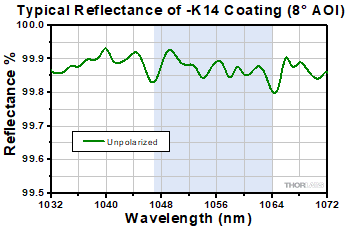 Click to Enlarge
Click to EnlargeClick Here for Raw Data
The shaded region on this plot denotes the range over which we guarantee the reflectance values shown to the left.
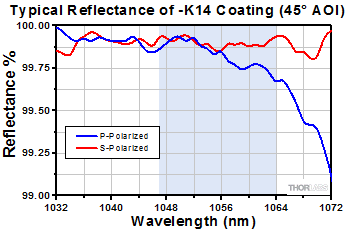
Click to Enlarge
Click Here for Raw Data
The shaded region on this plot denotes the range over which we guarantee the reflectance values shown to the left.

- Wavelengths: 532 nm and 1064 nm
- R > 98.0% at 532 nm for S- and P-Polarization
- R > 99.0% at 1064 nm for S- and P-Polarization
- Designed for Use from 0° to 45° AOI
- Damage Threshold:
- 8 J/cm2 @ 532 nm, Ø0.491 mm, 10 ns, 10 Hz
- 5 J/cm2 @ 1064 nm, Ø1.010 mm, 10 ns, 10 Hz

- Wavelength Range: 524 - 532 nm
- Ravg > 99.5% for S-Polarization
- Ravg > 99.0% for P-Polarization
- Designed for Use from 0° to 45° AOI
- Damage Threshold:
- Pulse: 8 J/cm2 @ 532 nm, Ø0.491 mm, 10 ns, 10 Hz
- CW Certification Measurement: 550 W/cm @ 532 nm, Ø1.000 mm
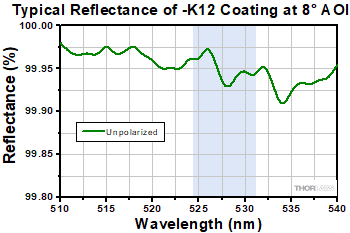 Click to Enlarge
Click to EnlargeClick Here for Raw Data
The shaded region on this plot denotes the range over which we
guarantee the reflectance values shown to the left.
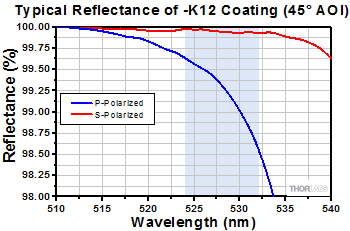 Click to Enlarge
Click to EnlargeClick Here for Raw Data
The shaded region on this plot denotes the range over which we
guarantee the reflectance values shown to the left.

- Wavelength Range: 349 - 355 nm
- Ravg > 99.5% for S- and P-Polarization
- Designed for Use from 0° to 45° AOI
- Damage Threshold: 3.5 J/cm2 @ 355 nm, Ø0.350 mm, 10 ns, 10 Hz
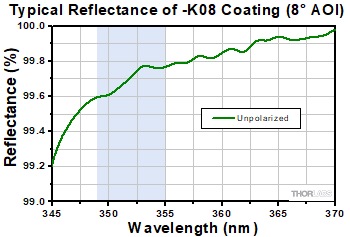 Click to Enlarge
Click to EnlargeClick Here for Raw Data
The shaded region on this plot denotes the range over which we
guarantee the reflectance values shown to the left.
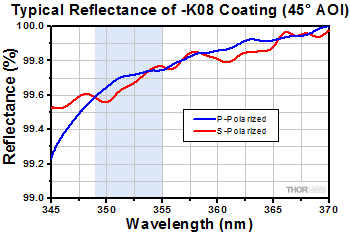 Click to Enlarge
Click to EnlargeClick Here for Raw Data
The shaded region on this plot denotes the range over which we
guarantee the reflectance values shown to the left.

- Wavelength Range: 262 - 266 nm
- Ravg > 99.0% for S- and P-Polarization
- Designed for Use from 0° to 45° AOI
- Damage Threshold: 2 J/cm2 @ 266 nm, Ø0.416 mm, 10 ns, 10 Hz
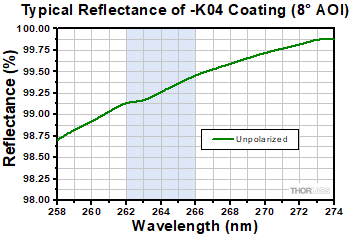 Click to Enlarge
Click to EnlargeClick Here for Raw Data
The shaded region on this plot denotes the range over which we
guarantee the reflectance values shown to the left.
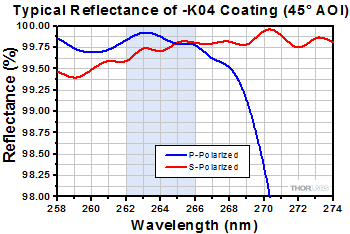 Click to Enlarge
Click to EnlargeClick Here for Raw Data
The shaded region on this plot denotes the range over which we
guarantee the reflectance values shown to the left.
 Products Home
Products Home














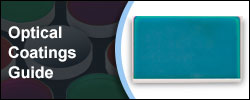
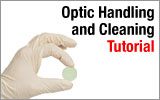

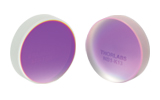
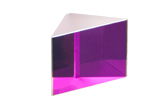

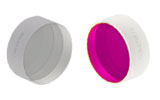
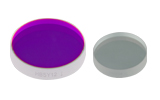
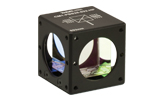
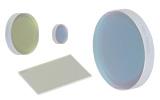


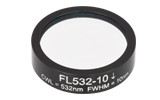
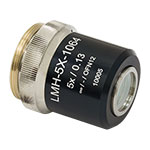

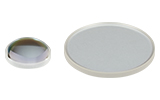


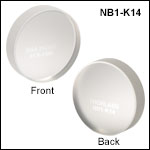
 Zoom
Zoom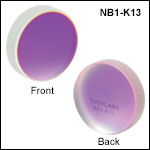
_0deg_G2-350.gif) Click to Enlarge
Click to Enlarge_45deg_G2-350.gif) Click to Enlarge
Click to Enlarge_0deg_G2-350.gif) Click to Enlarge
Click to Enlarge_45deg_G2-350.gif) Click to Enlarge
Click to Enlarge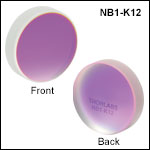
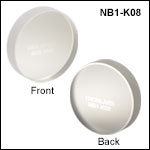
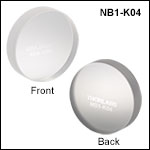
 Nd:YAG Laser Mirrors
Nd:YAG Laser Mirrors